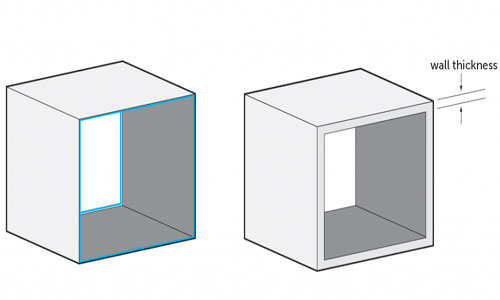
Wall thickness is necessary when you give your 3D model in print; otherwise, the 3D printer may not understand the thickness and thinness of the walls of your designs and print your model wrongly. So, it is the unwritten rule of designing 3D model in SketchUp to add wall thickness to your design. Paper-thin surfaces are strictly avoided for 3D printable models.
Setting the correct wall thickness needs your knowledge and proficient skills in designing. 3D printing materials and 3D models are two different subjects. The right wall thickness makes your 3D model print flawless, and it appears the same as you expect.
Choose the perfect wall for your 3D printing:
3D designing is an interesting field that grows rapidly in the world. This has made the craze for 3d printing materials used for various purposes. So, it is necessary to learn how to print a 3D model properly the way the design shows. In the designing software, you no need to work on the thickness surfaces to make your model. But when it comes to printing, it is an obligatory thing to add wall thickness. It helps 3D printer understand how thick of the surfaces are and print accordingly.
Wall thickness is defined as the distance between one surface and its opposite sheer surface. There are a few things that have an impact on choosing how much thickness you want for the surfaces. Materials would definitely come first in the list. The other factors that show a direct connection with the design are alignment, size and overall design.
A guide to proper 3D printing with the wall thickness:
Printing materials play definitely an important role, and depending on which, you can opt for the minimum thickness of your wall. It needs a basic knowledge of different printing materials. If your design needs strong materials like high detailed stainless steel or titanium, you can keep your wall thickness indeed thick as the materials allow you to do so.
The other factors are also there to watch on your 3D printing issue. Structure and design of your 3D models can be the decider of the wall thickness of the surfaces. For example, a print of vertical wall with 5mm2 wall surface needs 0.3mm wall thickness while a vertical wall with the 100mm2 wall surface needs 1mm thickness. If you are printing a horizontal wall with 100mm2 areas, then the wall thickness must be of 2mm. To set a proper wall thickness, you have to be correct while setting inputs like the size of the surface, the alignment (horizontal and vertical).
The materials like ceramics which are fragile need different attention from the strong and hard materials. The larger the model is, the stronger the structure must be – this is considered to be the general rule while printing on the comparatively fragile surface. For example, the ceramic model of 50 mm x 50 mm x 50 mm needs a minimum thickness of 3mm. a ceramic object with 100 mm x 100 mm x 100 mm has 6mm thickness for printable.
The other factors attached with 3D printing:
While preparing your model for 3D printing, you have to be very cautious while dealing with each factor of your design. The essential details are given below:
• It is common to give the primary attention on the wall with minimum thinness. But problems arise with the wall of maximum thickness. Thicker parts produce stress more than the thinner ones, resulting in a crack or break in the materials.
• To avert breaks on your print, it is always recommended to have an extra thickness of 5mm wall.
Your every design surface needs a recommended wall thickness to keep your model perfect for printing. It is an extraordinary process where you can visualize your virtual 3D models in real. So, having wall thickness is as much necessary as having a correct designing idea.
Article Source: i.materialise.com

- Cover Story
-
 SketchUp Can Help You Win Interior..
SketchUp Can Help You Win Interior.. -
 Best Laptops for SketchUp
Best Laptops for SketchUp -
 How to Resize Textures and Materials..
How to Resize Textures and Materials.. -
 Discovering SketchUp 2020
Discovering SketchUp 2020 -
 Line Rendering with SketchUp and VRay
Line Rendering with SketchUp and VRay -
 Pushing The Boundary with architectural
Pushing The Boundary with architectural -
 Trimble Visiting Professionals Program
Trimble Visiting Professionals Program -
 Diagonal Tile Planning in SketchUp
Diagonal Tile Planning in SketchUp -
 Highlights of some amazing 3D Printed
Highlights of some amazing 3D Printed -
 Review of a new SketchUp Guide
Review of a new SketchUp Guide
- Sketchup Resources
-
 SKP for iphone/ipad
SKP for iphone/ipad -
 SKP for terrain modeling
SKP for terrain modeling -
 Pool Water In Vray Sketchup
Pool Water In Vray Sketchup -
 Rendering Optimization In Vray Sketchup
Rendering Optimization In Vray Sketchup -
 Background Modification In sketchup
Background Modification In sketchup -
 Grass Making with sketchup fur plugin
Grass Making with sketchup fur plugin -
 Landscape designing in Sketchup
Landscape designing in Sketchup -
 Apply styles with sketchup
Apply styles with sketchup -
 Bedroom Making with sketchup
Bedroom Making with sketchup -
 Review of Rendering Software
Review of Rendering Software -
 Enhancing rendering for 3d modeling
Enhancing rendering for 3d modeling -
 The combination of sketchup
The combination of sketchup -
 Exterior Night Scene rendering with vray
Exterior Night Scene rendering with vray





